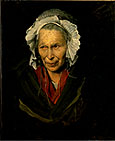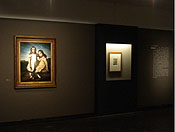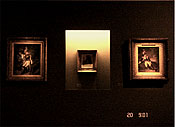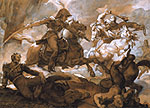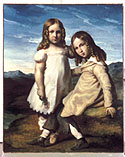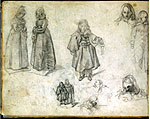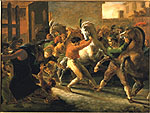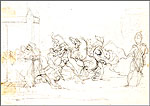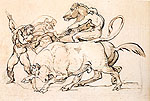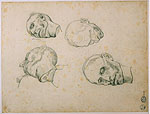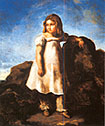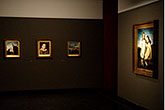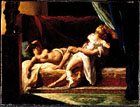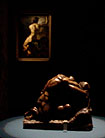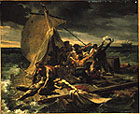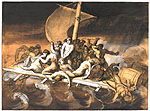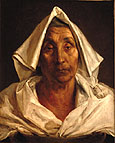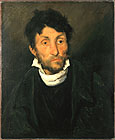The browser will either open the file, download it, or display a dialog.
|
Géricault. La Folie d'un Monde Géricault. La Folie d'un Monde |
||||||
| The superb 1991 exhibition celebrating the bicentenary of Théodore Géricault (1791–1824) at the Grand Palais in Paris might still be in many readers' minds. The show presented a fresh and unprejudiced view of the artist's work and life. Combining Régis Michel's new, to some even provocative, methodological approaches with impeccable archival research by Bruno Chenique and Sylvain Laveissière, it seemingly made Lorenz Eitner's traditional, but nevertheless paramount, monograph of 1983 obsolete in one stroke. As lengthy exhibition reviews by Eitner in the Burlington Magazine and by Henri Zerner in the New York Review of Books debated the merit of this retrospective, another project began to trouble Géricault scholars, collectors, and art dealers alike: Germain Bazin's ambitious catalogue raisonné, started in 1987 and supervised by the Wildenstein Institute. The Wildenstein project bluntly claimed to be the last verdict on the authenticity of the artist's increasingly growing corpus by virtue of its exhaustiveness and wealth of detailed information, thus glossing over many misattributions and astonishing contradictions that could only be in the interest of some who owned works attributed to Géricault, but certainly not to the general scholarly community.1 Nevertheless, the Paris show and Bazin's publication provoked a growing interest in the artist's life and work, stimulating new research that resulted in the Sociétée des Amies de Théodore Géricault's bulletin La Méduse, as well as in several Ph.D. theses,2 and finally, in several exciting exhibitions in Vancouver in 1997; at the École Nationale Supérieure des Beaux-Arts in Paris; and at the Fitzwilliam Museum in Cambridge in 1997/98,3 as well as the presentation of Géricault's La Vieille Italienne at the Louvre in 2002.4 Considering all these activities within the last fifteen years, one might be skeptical about another Géricault show, with more than 140 exhibits from public and private collections on both sides of the Atlantic, that boasts of no less than ten newly discovered works by the artist, dozens of paintings and drawings never seen in public, and many others not shown publicly since the legendary exhibition at the Galerie Charpentier of 1924. Yet Géricault: La Folie d'un Monde at the Musée des Beaux-Arts de Lyon, France's second largest art museum, is an ingenious event, intelligently and beautifully staged, and full of surprises. Its commissaire génerale, Bruno Chenique, and Silvie Ramond from the Musée des Beaux Arts de Lyon offer a multilayered view of the artist to the broader public and specialized scholars alike. Hence, a trip to Lyon is certainly worth the effort, especially for those who were unable to see the 1991 retrospective. | ||||||
|
The exhibition is based on the Musée des Beaux-Arts de Lyon's The Maniac of Envy (fig. 1), Géricault's drawings, as well as his beautiful copy after Raphael's Entombment that, however, did not make it into the current show, because one of the primary goals was to present the artist's political side. Thus, at Lyon, one regrouped three of the five known portraits of the insane: the Kleptomaniac from the Musée des Beaux-Arts in Ghent, and the Maniac of Gambling from the Louvre, in addition to the painting in Lyon. The Man Suffering from Delusions of Military Rank at the Oskar Reinhart Collection in Winterthur, Switzerland, could not be lent due to the founder's testamentary restrictions, while the Kidnapper at the Springfield Museum of Fine Arts in Massachusetts could not make the trip to France due to its fragile condition. | |||||
| Nevertheless, Chenique uses the three portraits of the insane as a clever starting point for his Gericauldian venture, making them a quintessential metaphor within Géricault's vision of the world rather than following the traditional perception of these portraits as an oddity within the enigmatic late period of the artist's short career (he died, after all, at the age of only 33). At Lyon, they become the raison d'être of the show that unfolds a rich and multifaceted spectrum of Géricault's life, work and political stance, leading to Chenique's, and the exhibition's, main message: Géricault was a political artist. The madness portrayed in the Maniacs, therefore, stands for the turbulent political, economic, and emotional situation that French society experienced before and after Waterloo. The madness also stands for Géricault's own suffering and desires within, and outside of, his own community, family, and artistic system. And finally, la folie stands for the perpetually repeated romantic conception of le peintre maudit that art historians desperately needed as a foil to justify Géricault's awkward, yet outstanding position. This was (and still is) based on describing the artist as a spoiled brat from well-off parents with no sense of social responsibility, as evidenced by his evading recruitment by the Grande Armé in 1811 by letting his father pay unlucky Claude Petit as replacement; his quasi-incestuous relationship with his aunt, Alexandrine Modeste Caruelle; and his lack of need to earn a living through painting. Having been described as le peintre noir de la violence et du drame, with a disturbing tendency to necrophiliac fantasies and a neurotic sensitivity for the ruptures of his time, Géricault was also associated with an unsurpassable enthusiasm for horses and military gear that, close to fetishism, reputedly contradicted his attraction to women, and thus placed him again and again in the corner of closet queers (e.g., James Small's latest contribution at the Boston CAA-conference of 22 February 2006: "Géricault and the Color of Classicism"). At the same time, he was perceived as a lonely chap without friends and, therefore, with no political awareness, naïve and self-pitying, but not too clever; and yet, above all, an artistic genius who paved the way for the avant-garde. He seemed bestowed with the luxury of independence, both blessed and cursed qualities that worked aesthetically and politically outside a system within which other artists, like Ingres and Delacroix, seemed to flourish. From historiography's beginning, Géricault was not only the painter of The Raft, but also the victim of arbitrary ideological needs and personal interests of those involved in researching or trading his work. Chenique does not eliminate these contradictions, but instead carves out specific aspects of a complex personality and argues for a new interpretation of this enigmatic, and somewhat disturbing, artist. | ||||||
| The show comprises 35 paintings, two sculptures, 94 watercolors and drawings, and fifteen lithographs as well as two paintings by other artists introduced as comparisons. The paintings are hung on neutral warm grey walls while the light sensitive works on paper are set in dark blue cases against a white ground (fig. 2). The exhibits are organized in fourteen thematic sections, each presenting one specific issue. The narrative begins with L'épopé napoléonienne: military subjects and sketches associated with the Charging Chasseur and the Wounded Cuirassier. The visitor is greeted by a powerful juxtaposition confronting the splendid sketch from the Brooklyn Museum with the Cuirassier assis sur un tertre from the Louvre. both framing the drawing of the Carabinier assis that once was in the Aimé-Azam collection (fig. 3). Here too one finds the first new "discovery"—a sketchy copy after Antoine-Jean Gros's monumental full-length Portrait of Lieutenant Legrand at the Los Angeles County Museum that, as Sylvain Laveissière pointed out in 1991, Géricault certainly knew from the 1810 Salon. Here, however, one wonders why the 1810 oil sketch credited to Gros is not attributed to Géricault, while the new small panel (!) is much inferior in quality. A happier confrontation, however, is the presentation, side by side, of two of the three known oil sketches for the Charging Chasseur, one from the Louvre and the one from the Alain Delon collection. They represent Géricault's first major canvas, his debut painting at the Salon of 1812. The comparison of the two sketches, one of them being far superior in quality, challenges the beholder's eye and might well puzzle both scholars and connoisseurs. | ||||||
| The next section deals with the fall of Bonaparte and the Restoration of Bourbon power in France. There is a charming little sheet of Sketches with Napoleon at Waterloo that was last seen in 2001.5 It also includes the forceful Execution of General de la Bédoyère, painted only a year after Goya's Execution of the Rebels on the Third of May, 1808, showing a squad of royal soldiers shooting one of Napoleon's loyal generals, and thus transforming him into a martyr of the Terreur blanche. It is a stirring image of the senseless atrocities by the Bourbon regime against its own people. Here, Géricault is clearly defined as a politically sensible observer who recognized the betrayal of the French by both their rulers: the megalomaniac emperor as well as the arbitrary king who followed him. The artist's critical stance towards the insanity of Napoleon's disastrous campaigns led him to join the royal musketeers in 1814 because he desperately hoped that Louis XVIII would be a more trustworthy ruler, and bring peace, only to be disappointed by the despotism that unleashed even more human slaughter. | ||||||
| This section also included the magnificent black chalk and gouache drawing of Eugène Beauharnais in Combat from the Louvre (fig. 4) with an intriguing—and expanded—dating of 1814 to 1818. Traditionally placed by Eitner, Grunchec and others in the years of 1818 to 1819 for stylistic reasons, and in accordance with a large group of heightened chiaroscuro drawings in black chalk, ink and wash, Chenique had implied a dating to 1813/14 in the exhibition held at Malmaison in 1999, based on documents he had recently discovered and presented a year before.6 The drawing's extended date is noteworthy because it implies that Christopher Sells's proposal for a revised chronology of the Chicago Album, as well as my own findings in the Zurich Sketchbook,7 cast doubts on the traditional perception of Géricault's artistic development that was established in 1960 by the Nestor of Géricault scholarship, Lorenz Eitner. The newly extended chronology indicated here becomes even more significant if one considers Chenique's late dating for the portraits of the Dedreux Children (fig. 5), i.e., after Géricault's return from Italy. These portraits are related to Folio 1 in the Zurich Sketchbook (fig. 6), which was drawn at the same time as Folio 34 in the Chicago Album, which is part of the sketchbook fragment that Eitner used as the basis for his chronology. Chenique does not deal with the question of chronology when presenting the children's portraits. This is understandable considering that his goal, in this exhibition and the accompanying publication, is to establish Géricault's political consciousness and positions. Nevertheless, his open dating for the Eugène Beauharnais in Combat, together with the late dating of the Dedreux Children to 1817/1818, bring back an issue of the artist's early chronology still not resolved. | ||||||
| The third part of the exhibition is devoted to the Race of the Riderless Horses, an event that Géricault had experienced at the end of the Roman carnival season in 1817. Besides the wonderful oil sketch for La Ripresa from the Musée des Beaux-Arts in Lille (fig. 7) and the similarly famous painting of La Mossa in the Louvre, the visitor is confronted with the show's first major triumph: three stunning, hitherto unrecorded, drawings for the so-called Barberi Race: two spontaneous sheets from Léon Cogniet's estate at the Musée des Beaux-Arts in Orléans (fig. 8), and another, calmer drawing from a private collection. They are important additions to our knowledge of the artist's oeuvre and certainly one of the most rewarding elements at Lyon, showing the tumultuous fury of the wild horses in bustling motion, tentatively restrained by strong yet struggling men, all set on paper in a swift, flamboyant, curly calligraphy. They are as radical as Géricault's most daring pictures, carving another of his battles into a timeless metaphor: the struggle between man and beast—between reason and instinct—not framed as a conflict between nature and civilization, but as an everlasting battle between rulers and the oppressed. As Eitner rightfully recognized, The Barberi would have become—had they been executed as a monumental canvas—a political allegory. But in Chenique's radical reading, they would have become an allegory for what might happen if "the people" were set free! | ||||||
| Following this are various sketches from daily life recorded while Géricault was in Italy from 1816 to 1817. These are similar to the contemporary artistic production by Bartolomeo Pinelli, François-Joseph Navez, and Jean-Victor Schnetz, to name only a few. There are various brigands together with the small, but charming Italian family from the Staatsgalerie Stuttgart, as well as the Prayer to the Virgin Mary from the École Nationale Supérieure des Beaux-Arts. During his Italian journey, many other artists utilized the subject of popular devotion, but in this drawing Géricault seems to have gone beyond the conventional expression of religious idolatry by engaging with issues of broader social significance, even allowing a critical note against the form of Catholicism that—back home—was restored under the Bourbon regime. Grouped apart from these genre scenes are The Butchers of Rome and related drawings showing yet another struggle between man and beast. Here too one gets to see an important discovery lifted from the holdings at Orléans: a beautiful pen and ink drawing capturing a busy scene around the slaughterhouses of the eternal city. The stars in this group, however, are the splendid Bull Tamers in bold, strong pen strokes with a little wash that have not been seen publicly for a very long time (fig. 9). (Once in the legendary Robert von Hirsch collection, they are now in the collection of Alain Delon). The laborers' nude, muscular bodies, one on a rearing horse, refer to classical tradition as well as timeless images of athletic strength and erotic fantasy. Roping and spearing a raging bull, their efforts to tame the powerful creature and its wild struggle for survival, are condensed here into yet another metaphor for an everlasting conflict between man and beast—and all the many psychoanalytical and political connotations attached to it. From there, it is but a short step to those works that replace metaphorical allusions with the real: various sketches of a Roman Beheading together with the Four Studies of the Severed Head of a Man from the Musée des Beaux-Arts et d'Archéologie Besançon (fig. 10), and the somewhat later Hanging of Arthur Thistlewood from the Musée des Beaux-Arts Rouen. In addition, there is Géricault's notorious still life from the Musée Fabre Montpellier showing an Arm and Two Feet. These are the consequential continuation from the Execution of General de la Bédoyère, but in a more sanguine and physical transformation, reflecting the artist's interest in the morbid, and in physical suffering. While Roman Beheading mirrors a world turned upside down during the carnival season, the still lifes of severed heads and limbs are usually connected with the development of his 'capolavoro': The Raft of the Medusa. In Lyon, however, they are all combined as a homogenous group, thus gaining a different meaning that goes beyond the traditional view that the artist defied traditional subject categories by oscillating between narrative history painting and the still life, allowing yet another political reading. | ||||||
| As soon as the visitor leaves the space devoted to decay, castration and slaughter, he is confronted with images of childhood and apparent innocence. Here, the Lyon show has its major triumph, starring not only the Double Portrait of Elizabeth and Alfred Dedreux that has not been seen in public for over 80 years, (fig. 5), but also another major discovery: The Full length Portrait of Elizabeth Dedreux Standing in a Landscape (fig. 11). Although unsigned and undated as in most cases, the painting is of superior quality and corresponds to Géricault's style and brushwork of 1817/18. Both children, Alfred and Elizabeth, were the offspring of Géricault's friend, the architect Pierre-Anne Dedreux. At Lyon, their portraits are combined – probably for the first time in nearly two centuries—with Elizabeth's pendant, Alfred Dedreux in a Landscape from the Metropolitan Museum (fig. 12). These portraits are impressive, not only because of their compact modeling, heavy angular contours, and stark contrast of light and dark, but also because of the children's provocative gaze at the beholder that makes them disturbing images of childhood. In their clever juxtaposition to the execution scenes and severed heads and limbs from the preceding section, one becomes conditioned to perceive even these children as little "monsters" who will be able to perform the most appalling atrocities if needed. In this section there is also an intriguing copy of Gericault's portrait showing Olivier Bro de Comères as a child by the sitter himself (neither listed in the catalogue nor on the photocopied list handed out at the entry). The original work in an American private collection could not be lent. Yet this was a clever move as it reveals how talented Bro de Comères was in copying a work by Géricault. Furthermore, it makes us aware of how little we still know about the oeuvres of all those rapins who were mingling in Géricault's studio, copying his pictures and imitating his style. One might remember the once well-known Study of a Dead Man's Head in the Art Institute of Chicago that, for generations, had fooled both connoisseurs and specialized scholars into thinking it was an autograph work by the master. However, after cleaning in 1985, it revealed the signature of Champmartin. | ||||||
| The next section deals with the Fualdès Affair and The Assassination of the Duc de Berry, thus recalling the tense political situation under the Bourbon regime. Repeatedly, and exhaustively, dealt with at other occasions (Paris 1991, Vancouver 1997), it is a reminder of how the country was seething with revolt against the ultra-royalists who wished to restore absolutism and who, to achieve their goal, initiated the Terreur blanche. The drawings, which might record early ideas for a history painting, show Géricault's position at the enlightened—at the time—far left, struggling to bring a political message into a convincing, generally understandable form. | ||||||
| After all these politics, the exhibition shifts into a somehow arbitrary interlude with Géricault's most intimate Desires. This section unites his erotic fantasies, the Threesome from the Getty Museum (fig. 13) and various versions of more or less violent coition. One of the exhibition's best mise en scène, however, is a wonderful juxtaposition of the famous sculpture of an Aroused Satyr Fondling a Bacchante's Private Parts set against the dramatic painting of a Male Nude in Back View from the Musées Royaux des Beaux-Arts de Belgique, Brussels (fig. 14). Both works intensify the other's corporeality and physical attraction, and thus bring bodily and artistic desires (close) to a climax. Here too, one finds another fine discovery—a small but powerful watercolor showing the Abduction of Europa, that, having been agreed as a loan at the very last minute, unfortunately made it neither into the catalogue nor to the hand list (fig. 15). | ||||||
| The next section is devoted to the painting that launched Géricault into the orbit of immortality: The Raft of the Medusa. It was inspired by an incident that took place in July 1816, when the French frigate, La Méduse, transporting the new governor, colonists, and soldiers to Senegal, foundered off the coast of Africa. Lacking sufficient lifeboats, approximately 150 passengers were forced to seek refuge on a hastily built raft, while the captain and his officers abandoned them in order to reach dry land more quickly. For thirteen days, the raft floated at sea while the men helplessly fought for food and space, turning to cannibalism and leaving only fifteen starving survivors at the end. A publication written by two of these survivors, the geographer Alexandre Corréard and the ship's surgeon Henri Savigny, revealed the incompetence of the captain who had owed his appointment to nepotism in the highest ranks of government. Subsequently, Corréard and Savigny charged the ship's aristocratic captain, along with the new Governor of Senegal and the Minister of the Navy, with negligence and mismanagement, engendering a political scandal that turned into a rallying point for the liberal opposition in Restoration France. The incident of La Méduse was widely discussed when, in the fall of 1817, Géricault returned home from Italy. His decision to base a monumental history painting on this affair was as exceptional at the time as his quasi-journalistic treatment of it resulted in one of mankind's most powerful images of human suffering. | ||||||
| The enormous canvas shows the moment when the rescue brig was first sighted. In a dramatic pyramidal massing of bodies in the picture's foreground, the dead overlaid by dying and suffering individuals full of resignation, it mounts to the still living and hopeful ones (the guilty survivors, because they were the cannibals) resurrected by sudden excitement. This group culminates in the heroic Negro whose sweaty muscular torso high gleams against the dramatic sky. With his strong left arm he signals to the cruising Argus with a cloth, thus saving the last survivors on the raft. This Negro, who according to Chenique, is actually of mixed blood, heightens the political message by implying the common mixing of white men with native women in the French colonies, thus symbolizing the future of European societies (mixed races challenging racist prejudices) and gaining a topical allusion that is not only of concern to the French, but all western societies. Géricault's dramatic canvas, represented in Lyon by an oil sketch from the Louvre (fig. 16), a small sculpture, and several powerful drawings (fig. 17) contextualized into a humanist tradition as well as into republican values and ideals, that—at the time—were protected by freemasonry and fostered by the liberals (then far left) while simultaneously promoting the fraternity of different people and pleading for the abolition of slavery. In the end, however, Jules Michelet's prophetic interpretation of 1848 still holds today: "It's our whole society that he [Géricault] placed on this Raft of the Medusa …". | ||||||
| The next two sections, The Black Sun, dealing with melancholy, and Portraits of the People, presenting various character studies of people from a lower social strata, lack the obvious poignancy of the earlier political interpretations. Nevertheless, one should enjoy the outstanding loans here: The Portrait of Louise Bro de Comères that has not been shown publicly since 1924, as well as the wonderful chalk preparatory sketch for it, both from a private collection in New York. Here too, one gets to see a preparatory sketch for a painting in the Virginia Museum of Fine Arts, Richmond that has traditionally been identified as A Scene of the Plague at Missolongi. Together with another hitherto unrecorded drawing from Orléans, (only reproduced in the catalogue) and based on newly discovered documents, the three images are now convincingly identified as Scenes of the Yellow Fever Epidemic at Cadiz of 1819. Another pleasurable surprise is the encounter with La Vielle Italienne (fig. 18), now deposited at the Musée André Malraux at Le Havre. Though this canvas might have made sense in combination with the Italian genre scenes, placing it among various portraits of proletarians, such as the so-called Carpenter from the Medusa and the stunning Turk, only confirm Chenique's recent identification of this painting as an autograph work by the Géricault. It is also the first time since Bazin's catalogue raisonné that the Carpenter is rightfully rehabilitated as an autograph painting by the master. | ||||||
| The next section, titled La Souveraineté des peuples, launches into a stronger political reading of Géricault's oeuvre, including such rarely seen drawings as Le Champ d'Asile, the various studies for The Slave Trade, and The Opening of the Doors of the Spanish Inquisition. A splendid sequence of mature chiaroscuro drawings in black chalk and wash, with white heightening and sometimes even with watercolor, is presented here: the beautiful Black Standard Bearer from the Stanford Museum of Art, Colonel Bro at Santo Domingo from a Swiss private collection, the Moor on a Rearing Horse from an American private collection, and General Kléber leading an Attack at Saint Jean d'Acre from the Musée des Beaux-Arts Rouen. This section draws visitors' attention to the colonial crime and the history of slavery, both issues not yet officially dealt with by any French government of the so-called "post-colonial" era. Thus, one realizes how explosive Géricault's oeuvre is, and how dangerous it still appears to the French establishment in whatever political corner this might be situated. To represent this artist uncompromisingly as a political painter, in the clear-cut manner applied by Chenique, is already a heroic notion in France, and might not have been possible in Paris today, or for that matter, fifteen years ago. The political framing at Lyon is highly stimulating and reveals a context within which French Romanticism was developed, a context that is explained only very rarely. Yet, one might remember Henri Zerner's warning "not to reduce this puzzling artist to a left-wing stereotype."8 And that is exactly where Chenique succeeds, especially when dealing with the next topic—madness. | ||||||
| Treating the Maniacs with a fresh look, Chenique makes it clear that the concept of madness in Géricault's portraits of mentally deranged people was more complex than orthodox opinion had allowed so far. Indeed, the artist's painstaking efforts to render his immediate sensations when observing these individuals were rooted in empathy for those who lived at the border of society; and yet, one must not forget that the paintings' titles were not given by Géricault, but were fabricated at a later date to tame what seemed threatening about them. The first work in the exhibition dealing with a somatically perceivable illness is an impressive ink and wash drawing from Géricault's Italian journey showing a voyeuristic crowd gathering around an Epileptic Who Suffers an Attack. The sheet had resurfaced on a sale in 2005 and had, so far, only been known from two vague sketches that Germain Bazin and Wheelock Whitney published under the more tempered titles Un accident dans la rue (Bazin) and Figures surrounding an Injured Man (Whitney).9 Chenique's interpretation is as tempting as it is convincing when combined with the rest of the group treating French insanity under the Bourbon restoration. Part of this is reflected in the drawing of General Letellier after his Suicide, who, because he could not come to terms with ordinary life after the insanity of the Napoleonic campaigns, shot himself in grief over the loss of his young wife. For Chenique, Letellier's suicide is symptomatic of a society that tried to get over a traumatic defeat while feeling trapped by yet another nightmare under the Bourbon regime. | ||||||
|
The section then leads to the exhibition's next highlight: the Portraits of the Insane (fig. 19). They still constitute one of the most challenging enigmas in the artist's career and certainly of early modern European painting. An early twenty-first century beholder, accustomed to the creative output of Cindy Sherman, Nan Golding or the Chapman Brothers—apart from all the upsetting images brought to our homes via TV and internet—might not be disturbed at all when confronting these portraits. Indeed, he or she might recognize an empathic trait in the artist's approach and a strong realist element avant la lettre when seeing these images of individuals at society's periphery. Disillusionment, derangement, sadness, loneliness, anger, suspicion and greed are all part of human fate. Yet even if the faces of the so-called Maniacs come out of a dark background, apparently in accordance with Johann Caspar Lavater's most dangerous simplifications, they are not threatening anymore. Instead, they make us aware of how quickly the capitalist system introduced by the industrial revolution created its victims, and the insanity not only of those who could not adjust to the new order, but also the lunatic greed of those who were actually responsible for it. Furthermore, they show how concepts of madness and health, clinically definable insanity or ideals of beauty, notions of reason, truth, or even reality, are interchangeable units within the arbitrariness of whatever ideological system where one happens to reside. The line between the reasonable and the unreasonable, between the sane and the insane, is very thin, and none managed to transform it as convincingly into painting as Théodore Géricault. | |||||
| The final section explores the artist's various visits to London, again within a political framing. Images from Various Subjects Drawn from Life and on Stone, such as Pity The Sorrows of a Poor Old Man and The Paralytic Woman, both present viewers with the dilemma of the modern industrialized metropolis and the capitalistic system's breakdown. The lithographic suite, Grands chevaux, however, is represented with the beautiful, only recently resurfaced preparatory drawing from a Swiss private collection and its accompanying print of Old Horse at an Inn's Door. Given the political tone in this section, the lack of the elegant equestrian subjects from Epsom, and similarly cheerful images (they exist!), is palpable. Instead, one is confronted with laboring horses, the Louvre's beautifully somber Lime Kiln and another new attribution to Géricault's oeuvre of a small oil sketch with a Dead Horse. Eventually, the show finds its fitting end with the splendid and beautifully sad Horse-Butcher's Cart from a French private collection. | ||||||
| The catalogue adds to the growing literature on Géricault, including the improved French version of Bruno Chenique's Vancouver essay "On the Far Left of Géricault", an ambitious attempt to place Géricault within a pan-European Romantic movement by Pierre Wat, as well as cleverly written, brief, hortatory prefaces to the various sections, again by Chenique. It also includes a wonderful homage to the most gifted German scholar working on French Romanticism within the last generation, the prematurely silenced Stefan Germer (1958 – 1998) , whose introductory text is provided here in a French translation. The illustrations are generally excellent, but the catalogue entries might have deserved more consistency. One might forgive that there was not enough space to explain in detail how and why the author sees this or that newly discovered and/or attributed—or yet unpublished—work as by Géricault, but bibliographic information on the exhibits would have been less arbitrary by not being limited to Eitner and several French authors (mainly Clément, Bazin, Laveissière and Chenique). The catalogue includes several works that have not yet been published (several drawings and watercolors from Orléans and private collections), indicating that there is much more to be discovered. To sum up, one has to stress that both the catalogue and the installation of the exhibition pursue their message effectively, the message that Géricault was more than the painter of The Raft. In addition, he was a politically conscious personality—not necessarily on the far left by our current standards—but certainly among the ultra-liberals of his time. He is portrayed as ethically sound and politically critical as one should hope any educated member of a civilized society to be. Together with the many new discoveries and the many works by Géricault rarely seen in public, the exhibition at Lyon offers much excitement along with some minor irritation, hallmarks of an original, experimental show, making it a most stimulating plunge into la folie d'un monde. | ||||||
|
Dr. Marc Fehlmann FRSA |
||||||
|
1. See Lorenz Eitner on Germain Bazin's Théodore Géricault: Étude critique, documents, et catalogue raisonné in: The Burlington Magazine, vol. CXXXIII, No. 1057, April 1991, 253-257. See also The Burlington Magazine, Vol. CXXXVI, No. 1100, November 1994, on Vol. IV: "Le Voyage en Italie", and Vol. V: "Le Retour à Paris: Synthèse d'Expertises Plastiques". 771-773; and The Burlington Magazine, Vol. CXL, No. 1148, November 1998, on Vol. VI and Vol. VII, 760-763. 2. E. G. Bruno Chenique, Les Cercles politiques de Géricault (1791 – 1824), Ph.D. dissertation, (Paris I, Panthéon-Sorbonne, 2 vols., Lille: Presse Universitaires du Septerion, 1998). 3. Emmanuelle Brugerolles, Ed., Géricault:Dessins & estampes des collections de l'École des beaux-arts, Exh. cat. l'École nationale supérieure des beaux-arts, (Paris/The Fitzwilliam Museum, Cambridge, 1997-1998). See also Serge Guilbaut, Maureen Ryan and Scott Watson (Eds.), Théodore Géricault. The Alien Body: Tradition in Chaos, exh. cat. (Vancouver: The Morris and Helen Belkin Art Gallery, University of British Columbia, 1997). 4. E. G. Bruno Chenique, "La Vieille Italienne de Géricault," Le Tableau du mois, (18 January-25 March 2002) No. 86, Musée du Louvre, 2002, 1-4. 5. Louis-Antoine Prat, Dessins romantiques français provenant de collections parisiennes, exh. cat. Musée de la vie romantique, No. 4. 24-25, 2001. 6. E. G. Bruno Chenique, "Le prince vice-roi à l'armée de Russie délivrant un de ses officiers d'ordonnance polonais surpris par des Cosaques," in Alain Pillepich (Ed.), Eugène de Beauharnais. Honneur & fidélité, exh. cat. Musée national des châteaux de Malmaison et Bois-Préau, (Paris: Edition de la Réunion des musées nationaux, No. 79, 1999). 96. See also "Denon-Géricault: une commande inédite pour le salon de 1814" in La Méduse No. 6, December 1998, 2-3. 7. Christopher Sells, "A Revised Dating for Part of Géricault's Chicago Album," Master Drawings, Vol. XXXVII, No. 4, 1989, 341-357; and Marc Fehlmann, Théodore Géricault: Das Zürcher Skizzenbuch, Ph.D. dissertation, University of Zurich 1998. (Bern: Stämpfli 2003) 50-55. 8. Henry Zerner, "Mysteries of a Modern Painter," The New York Review of Books, Vol. XXXIX, No. 5, 5 March 1992, 36-39. 9. Wheelock Whitney, Géricault in Italy, (New Haven/London: Yale University Press, 1997). 51, figs. 56 and 57. |


